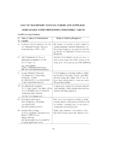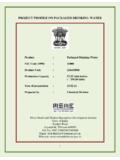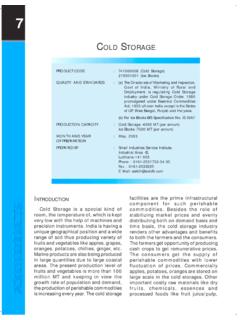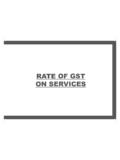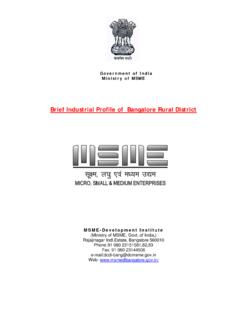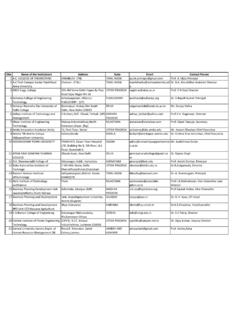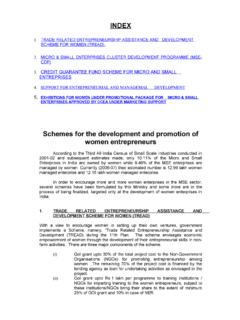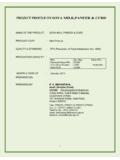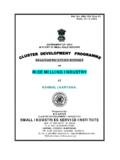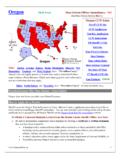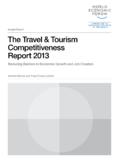Transcription of Haridwar District - DCMSME
1 Industrial profile of District - Haridwar (Uttarakhand) Page 2 Haridwar District Industrial profile of District - Haridwar (Uttarakhand) Page 3 Contents S. No. Topic Page No. 1. General Characteristics of the District 4-5 Location & Geographical Area 5-5 Topography 5-5 Availability of Minerals. 6-6 forest 7-7 Administrative set up 8-10 2. District at a glance 10-13 Existing Status of Industrial Area in the District Haridwar 13-15 3. Industrial Scenario Of District Haridwar 16-32 Industry at a Glance 16-16 Year Wise Trend Of Units Registered 17-17 Details Of Existing Micro & Small Enterprises & Artisan Units In The District 18-18 Large Scale Industries / Public Sector undertakings 19-23 Major Exportable Item 23-23 Growth Trend 24-24 Vendorisation / Ancillarisation of the Industry 24-24 Medium Scale Enterprises 25-31 List of the units in Haridwar District 25-30 Major Exportable Item 31-31 Service Enterprises 31-31
2 Potentials areas for service industry 31-31 Potential for new MSMEs 32-32 4. Existing Clusters of Micro & Small Enterprise 33-33 Detail of Major Clusters 33-38 5. General issues raised by industry association during the course of meeting 39-39 6 40- 41 7. 41- 42 Steps to set up MSMEsAdditional information Industrial profile of District - Haridwar (Uttarakhand) Page 4 Brief Industrial Profile of Haridwar District 1. General Characteristics of the District Haridwar District is a District in the state of Uttarakhand, India.
3 It is headquartered at Haridwar which is also its largest city. The District is ringed by the districts Dehradun in the north and east, Pauri Garhwal in the east and the Uttar Pradesh districts of Muzaffarnagar and Bijnor in the south and Saharanpur in the west. A paradise for nature lovers and one of the seven holiest places of Hinduism, Haridwar presents a kaleidoscope of Indian culture and civilization. Haridwar District came into existence on 28 December 1988 as part of Saharanpur Divisional Commissionary, On September 24, 1998 Uttar Pradesh Legislative Assembly passed the 'Uttar Pradesh Reorganisation Bill', 1998', eventually the Parliament also passed the Indian Federal Legislation - 'Uttar Pradesh Reorganisation Act 2000', and thus on 9 November 2000, Haridwar became part of the newly formed Uttarakhand (then Uttaranchal), the 27th state in the Republic of India.
4 As of 2011 it is the most populous District of Uttarakhand (out of 13). Important towns in the District are Haridwar , BHEL Ranipur, Roorkee, Manglaur, Dhandera, Jhabrera, Laksar, Landaura and Mohanpur Mohammadpur. According to the 2011 census Haridwar District has a population of 1,927,029, roughly equal to the nation of Lesotho or the US state of West Virginia. This gives it a ranking of 244th in India (out of a total of 640). The District has a population density of 817 inhabitants per square kilometre (2,120 /sq mi). Its population growth rate over the decade 2001-2011 was %.
5 Haridwar has a sex ratio of 879 females for every 1000 males, and a literacy rate of Being a place of intense religious significance, Haridwar also hosts several religious festivals throughout the year; popular among them are the Kavad Mela, Somvati Amavasya Mela, Ganga Dashara, Gughal Mela,in which around 20-25 lacs ( million) people take part. Apart from these, there is the mammoth Kumbh Mela which takes place once in every twelve years, when the planet Jupiter (Brihaspati) comes into the sign Aquarius (Kumbha).
6 First written evidence of the Kumbha Mela can be found in the accounts of Chinese traveller Huan Industrial profile of District - Haridwar (Uttarakhand) Page 5 Tsang or Xuanzang (602 - 664 ), who visited India in 629 AD. The 1998 Maha Kumbh Mela saw over 80 million pilgrims visiting this city, to take a dip in the holy river Ganges. Location & Geographical Area Haridwar District , covering an area of about 2360 is in the western part of Uttarakhand state of India. It's latitude and longitude are degree north and degree east respectively.
7 The height from the sea level is mts. The District came into existence on 28th Dec. 1988. Prior to its inclusion in the newly created state of Uttarakhand, this District was a part of Saharanpur Divisional Commissionary. The District is ringed by Saharanpur in the west, Dehradun in the north and east, Pauri Garhwal in the east, Muzzaffar Nagar and Bijnor in the south. The District headquarter is situated in the Roshnabad, at a distance of about 12 kms from railway station. The Collectorate, Vikas Bhawan, District Judiciary, Office, Police line, District Jail, District sports stadium, Jawahar Navodaya Vidyalaya etc.
8 Are the prime establishments of this area. The District is administratively subdivided into three tehsils Haridwar , Roorkee and Laksar and six development blocks Bhagwanpur, Roorkee, Narsan, Bahadrabad, Laksar and Khanpur. Haridwar is one of the first towns where Ganga emerges from the mountains to touch the planes. As per the 2001 census, the population of the District is 14,44,213. Due to Haridwar 's location on the bank of river Ganga, it has plenty of water resources and almost all kind of food grains are produced here in abundance.
9 Topography Temperatures: Summers: 15 C - 42 C Winters: 6 C - C The temperature during the summer months ranges from 15 C - 42 C, while in the winter months the temperature varies within 6 C C. Monsoon rains occurs mainly during the summer time in Haridwar District . Industrial profile of District - Haridwar (Uttarakhand) Page 6 ECONOMY Agriculture is the mainstay of this well irrigated District . Industrialisation had commenced with the establishment of Central Government owned Public Sector plants (PSUs) of Hindustan Antibiotics Limited and Bharat Heavy Electricals Limited, in pre-Uttarakhand 1960s period.
10 The State Industrial Development Corporation of Uttarakhand (SIDCUL) has now established one new industrial development zone in the District , adjacent to Shivalik Nagar near Haridwar , to encourage industrialization; with industrial giants like Hindustan Lever, Dabur, Mahendra & Mahendra and Havells having moved in, it is making the desired progress. Not insignificant to the District s economy is the contribution of Hindu pilgrims who visit the holy places and attend the religious fairs in large numbers. Availability of Minerals.
